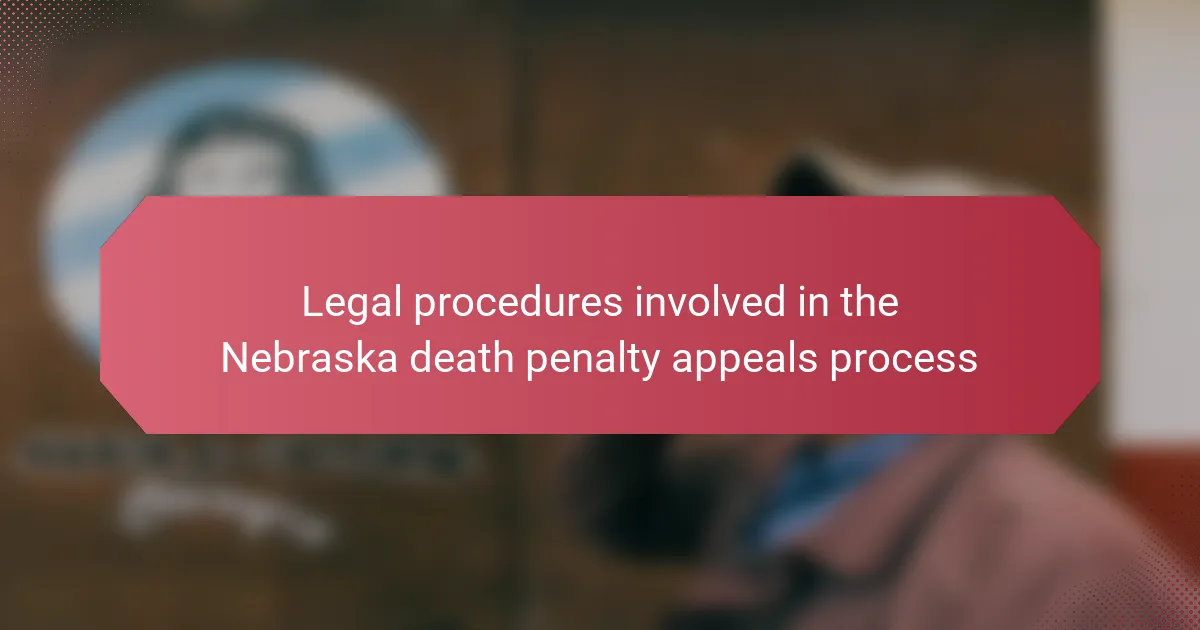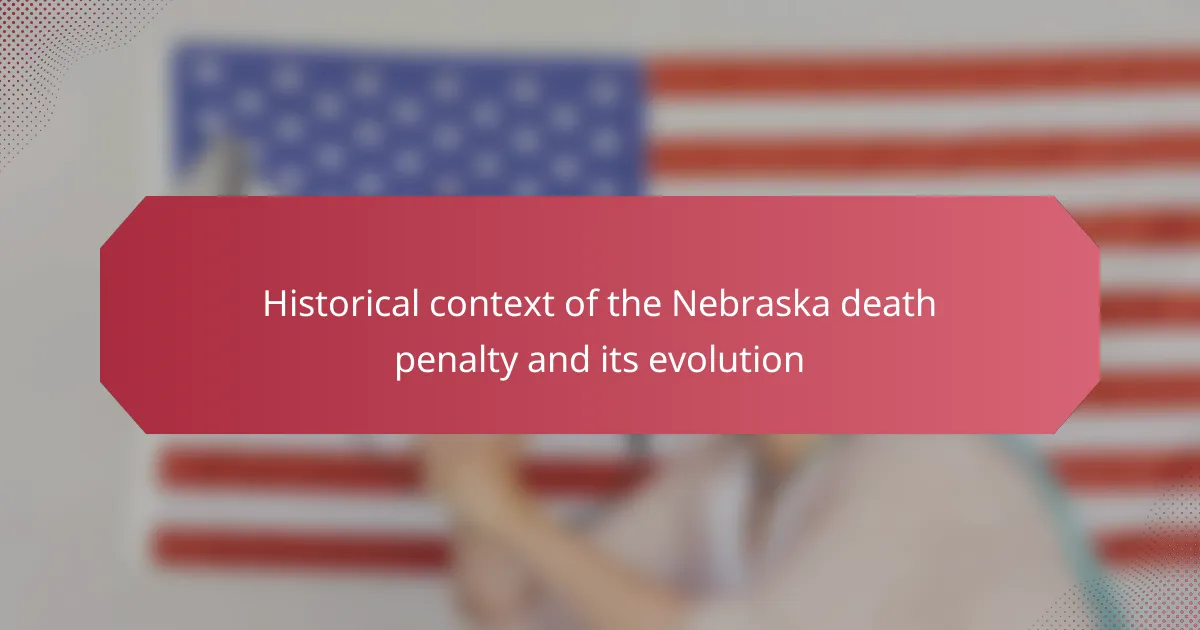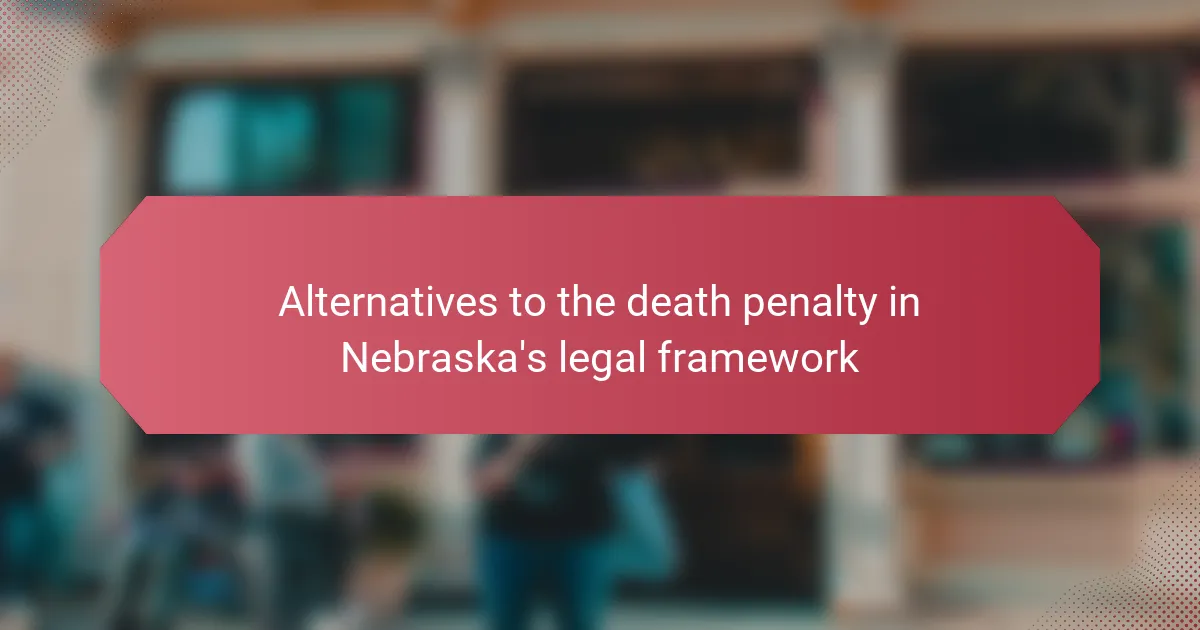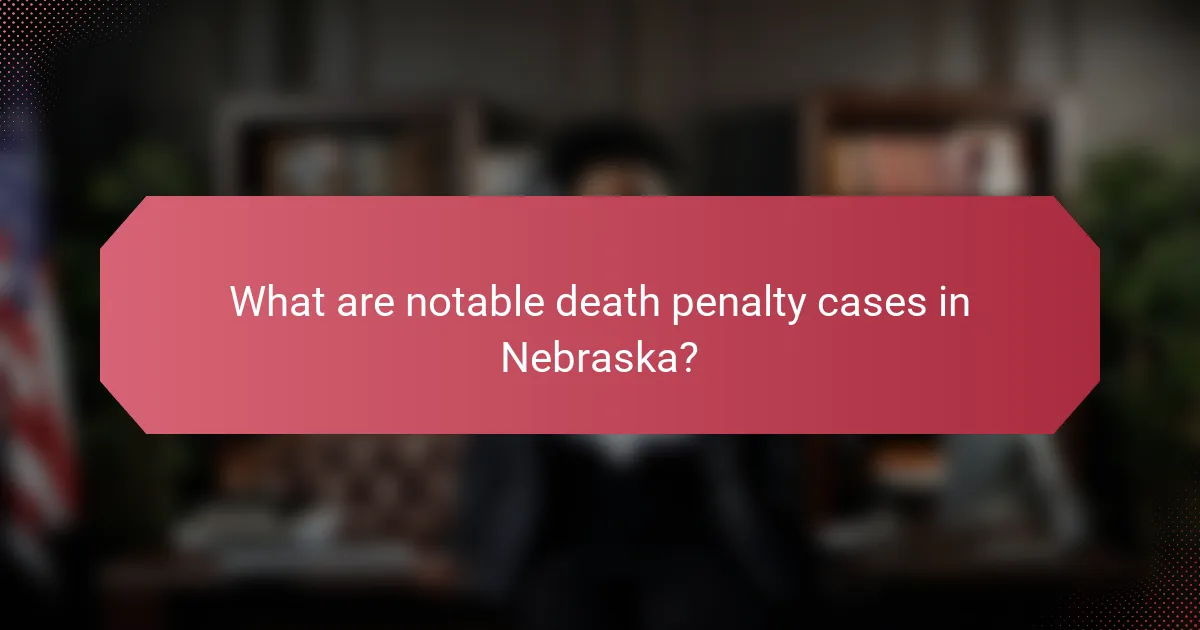
What are notable death penalty cases in Nebraska?
Notable death penalty cases in Nebraska include the cases of Charles Starkweather, who was executed in 1959 for a series of murders, and Carey Dean Moore, executed in 2018 for the 1976 murders of two taxi drivers. Starkweather’s case became infamous and highlighted issues surrounding juvenile offenders and the death penalty. Moore’s case was significant as he was the longest-serving death row inmate in Nebraska’s history. Another notable case is that of John Joubert, who was executed in 1996 for the murders of two boys in the 1980s. These cases illustrate the complexities and controversies surrounding the death penalty in Nebraska.
How has the death penalty evolved in Nebraska?
The death penalty in Nebraska has undergone significant changes since its inception. Initially, Nebraska adopted the death penalty in 1873. The state primarily used hanging as the method of execution until 1903, when it switched to electrocution. In 1972, the U.S. Supreme Court’s decision in Furman v. Georgia led to a temporary halt of the death penalty nationwide, including in Nebraska.
In 1979, Nebraska reinstated the death penalty, this time introducing lethal injection as the method of execution. However, in 2015, the Nebraska legislature passed a bill to abolish the death penalty, overriding a veto from the governor. The law went into effect in 2016, marking a significant shift in the state’s stance on capital punishment.
Despite the abolition, a referendum in 2016 allowed voters to reinstate the death penalty, which they did, reaffirming its legality. As of 2023, Nebraska continues to have the death penalty, though executions have been infrequent due to legal and logistical challenges. This evolution reflects ongoing debates about morality, legality, and effectiveness surrounding capital punishment in the state.
What historical events influenced the death penalty in Nebraska?
The death penalty in Nebraska has been influenced by several historical events. The state’s first execution occurred in 1870, establishing a legal precedent for capital punishment. In 1913, the Nebraska Legislature abolished public executions, shifting to private executions. The 1972 U.S. Supreme Court case Furman v. Georgia led to a temporary halt of the death penalty nationwide, impacting Nebraska’s practices. In 1979, Nebraska reinstated the death penalty, introducing lethal injection as the method of execution. The 2015 repeal of the death penalty by the Nebraska Legislature marked a significant change in public sentiment and legal framework. However, a voter referendum in 2016 reinstated it, reflecting ongoing debates about capital punishment in the state.
What legal changes have impacted death penalty cases in Nebraska?
In Nebraska, significant legal changes impacting death penalty cases include the abolition of the death penalty in 2015. The Nebraska Legislature voted to repeal the death penalty, which was signed into law by Governor Pete Ricketts. This repeal was a landmark decision, as it marked Nebraska as the first conservative state to eliminate capital punishment in over 40 years. However, in 2016, a ballot initiative reinstated the death penalty, showcasing the contentious nature of the issue. The Nebraska Supreme Court has also ruled on various cases, influencing the application and procedures surrounding capital punishment. These legal shifts reflect ongoing debates about the morality and efficacy of the death penalty in the state.
What are the key characteristics of Nebraska death penalty cases?
Nebraska death penalty cases are characterized by a combination of legal procedures, public opinion, and historical context. The state has a unique legal framework governing capital punishment. Nebraska’s death penalty law requires a bifurcated trial process. This involves separate phases for determining guilt and sentencing. Additionally, the state has experienced significant public debate regarding the morality and efficacy of capital punishment. Historical cases, such as the 2008 case of Carey Dean Moore, illustrate the complexities involved. Nebraska’s Supreme Court has played a crucial role in shaping death penalty legislation. The state has also seen shifts in execution methods, particularly the transition to lethal injection. These characteristics reflect Nebraska’s evolving stance on capital punishment and its implications for justice.
How do the crimes committed in these cases compare?
The crimes committed in these Nebraska death penalty cases vary in severity and nature. Some involve premeditated murder, while others include acts of extreme violence. For instance, one case may involve multiple victims, indicating a higher level of brutality. In contrast, another case could center on a single victim with a more calculated approach.
Statistical data shows that the motives behind these crimes also differ significantly. Some offenders acted out of financial gain, while others were driven by personal vendettas or mental health issues. The legal outcomes reflect these differences, with some cases resulting in swift convictions and others facing prolonged appeals.
Overall, the comparison highlights a range of criminal behaviors and motivations, underscoring the complexity of each case.
What sentencing patterns are observed in notable cases?
Sentencing patterns in notable Nebraska death penalty cases often show a trend towards lengthy appeals and varied outcomes. Many cases involve significant delays between sentencing and execution. For instance, in the case of Carey Dean Moore, he was sentenced to death in 1979 but did not face execution until 2018. Additionally, racial disparities are evident, with minority defendants receiving harsher sentences compared to white defendants. A study by the Nebraska Commission on Law Enforcement and Criminal Justice highlighted that cases involving white victims often result in more severe penalties. Furthermore, juror attitudes and public opinion influence sentencing patterns, as seen in the case of Michael Ryan, where community sentiment affected the trial’s proceedings. Overall, notable cases in Nebraska illustrate complex sentencing dynamics influenced by various social and legal factors.
What role do public opinion and media play in these cases?
Public opinion and media significantly influence death penalty cases in Nebraska. They shape perceptions and attitudes toward capital punishment. For instance, public sentiment can sway legislative actions and judicial decisions. Media coverage often highlights specific cases, affecting public awareness and opinion. This coverage can lead to increased scrutiny of legal proceedings. Additionally, sensationalized reporting may evoke emotional responses from the public. Studies show that media framing can impact jury decisions in capital cases. Overall, public opinion and media serve as critical factors in the dynamics of death penalty cases.
How has public sentiment influenced death penalty legislation in Nebraska?
Public sentiment has significantly influenced death penalty legislation in Nebraska. Over the years, shifts in public opinion have led to legislative changes regarding capital punishment. In 2015, the Nebraska legislature voted to abolish the death penalty, reflecting a growing opposition among the public. A 2016 poll indicated that 61% of Nebraskans supported the repeal of capital punishment. This public sentiment prompted a successful referendum to reinstate the death penalty in 2016, showcasing the power of voter influence. Legislative decisions in Nebraska have often mirrored the prevailing attitudes of its citizens, demonstrating a direct correlation between public sentiment and policy changes regarding the death penalty.
What media coverage has shaped perceptions of notable cases?
Media coverage has significantly shaped perceptions of notable Nebraska death penalty cases. High-profile cases, such as those of Michael Ryan and Carey Dean Moore, received extensive media attention. Coverage often highlighted the details of the crimes and the legal proceedings. This reporting influenced public opinion on the death penalty in Nebraska. For instance, sensationalized headlines created a sense of urgency and fear. Additionally, editorial pieces debated the morality and effectiveness of capital punishment. Studies show that media framing can sway public attitudes toward legal outcomes. Overall, the media’s portrayal has played a crucial role in shaping societal views on these cases.

What are some significant case studies of the Nebraska death penalty?
Significant case studies of the Nebraska death penalty include the cases of Charles Starkweather, the 1958 serial killer, and the 2002 case of Michael Ryan. Charles Starkweather was convicted for the murder of 11 people. His case led to widespread media attention and influenced public opinion on capital punishment. Michael Ryan was sentenced to death for the 1985 murder of 2-year-old Mary Beth Hagan. His case highlighted issues of mental health and competency in death penalty cases. In 2015, the Nebraska legislature voted to abolish the death penalty, marking a significant shift in state policy. These cases illustrate the complexities and controversies surrounding the death penalty in Nebraska.
Which cases are considered landmark within Nebraska’s death penalty history?
The landmark cases in Nebraska’s death penalty history include State v. McCoy, State v. McGhee, and State v. McKenzie. State v. McCoy (1987) was significant as it addressed the constitutionality of the death penalty statutes. The Nebraska Supreme Court ruled that the state’s death penalty law was constitutional, affirming its application. State v. McGhee (2001) involved a challenge to the method of execution, focusing on lethal injection protocols. The court upheld the use of lethal injection, setting a precedent for execution methods. State v. McKenzie (2008) was notable for its examination of mental competency in death penalty cases. The ruling emphasized the importance of mental health evaluations before sentencing. These cases collectively shaped the legal landscape of capital punishment in Nebraska.
What were the circumstances surrounding the case of [specific case]?
It is not possible to provide an answer as the specific case has not been identified. Without the name of the case, I cannot detail the circumstances surrounding it.
What legal precedents were set by the case of [specific case]?
It is not possible to provide an answer without knowing the specific case referenced. Each case has unique legal precedents that need to be identified.
How did the case of [specific case] impact the death penalty in Nebraska?
It is not possible to provide an answer without knowing the specific case referenced. Each case has unique implications for the death penalty in Nebraska.
What were the outcomes of the appeals in [specific case]?
It is not possible to provide an answer without specifying the particular case in question. Each case has distinct outcomes based on its unique circumstances and legal arguments presented during the appeals.
How did this case influence future death penalty cases in Nebraska?
This case significantly influenced future death penalty cases in Nebraska by shaping legal precedents. It established important standards regarding the application of capital punishment. The ruling highlighted constitutional issues surrounding due process and the Eighth Amendment. Subsequent cases referenced this decision to challenge the legality of execution methods. Legal representatives used the case to argue for more stringent safeguards in death penalty cases. It also prompted legislative discussions on the death penalty’s morality and efficacy. Over time, this case contributed to a more cautious approach toward capital punishment in Nebraska. The impact is evident in later court decisions that reflect its principles.
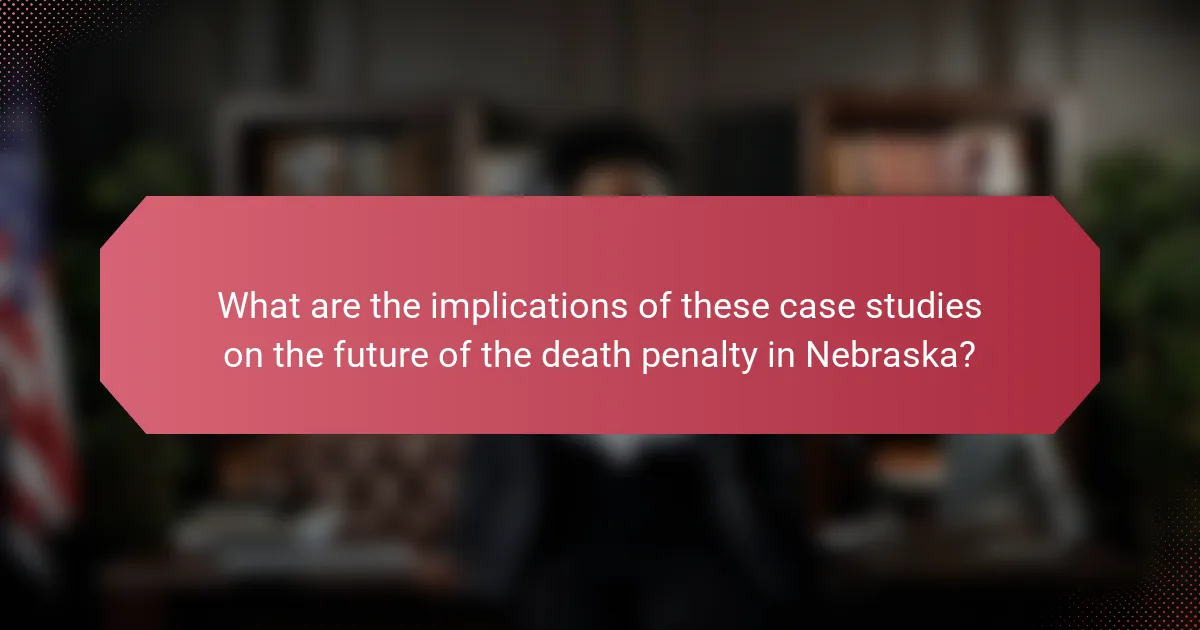
What are the implications of these case studies on the future of the death penalty in Nebraska?
The implications of these case studies on the future of the death penalty in Nebraska suggest a potential shift in public opinion and policy. Historical cases, such as those involving wrongful convictions, have raised concerns about the reliability of capital punishment. Data shows that states with high-profile exonerations often see a decline in support for the death penalty. Additionally, the financial burden of prolonged legal battles in death penalty cases is a significant factor influencing legislative discussions. These elements indicate that Nebraska may reconsider its stance on capital punishment in light of evolving societal values and judicial outcomes.
What are the current trends in death penalty cases in Nebraska?
Current trends in death penalty cases in Nebraska show a significant decline in executions. The state has not carried out an execution since 2018. Public opinion is shifting towards opposition to the death penalty. Legislative efforts to abolish capital punishment have gained momentum. In 2021, a bill to repeal the death penalty was introduced but did not pass. There is increasing focus on wrongful convictions and racial disparities in sentencing. The Nebraska Supreme Court has also ruled on issues regarding lethal injection protocols. These trends indicate a growing movement towards reevaluating the death penalty’s role in the justice system.
How are recent cases reflecting changes in public policy?
Recent cases in Nebraska’s death penalty context illustrate significant shifts in public policy. Legislative changes have emerged due to evolving public sentiment regarding capital punishment. For instance, the repeal of the death penalty in 2015 reflects a broader trend towards abolition in various states. Polls indicate increasing public support for alternatives to capital punishment. Additionally, recent court rulings emphasize the importance of due process and fair trials. These developments indicate a move towards more humane justice practices. Overall, the interplay between public opinion and legislative action is reshaping Nebraska’s approach to capital punishment.
What are the potential future challenges for the death penalty in Nebraska?
Potential future challenges for the death penalty in Nebraska include legal, ethical, and procedural issues. Legal challenges may arise from evolving interpretations of constitutional rights. Ethical concerns focus on the morality of capital punishment. Procedural challenges involve difficulties in obtaining lethal injection drugs due to pharmaceutical companies refusing to supply them. Additionally, public opinion is shifting against the death penalty, which may influence legislative changes. Recent data shows a decline in executions nationwide, reflecting changing societal attitudes. These factors together indicate a complex landscape for the future of the death penalty in Nebraska.
What lessons can be learned from notable Nebraska death penalty cases?
Lessons from notable Nebraska death penalty cases include the importance of thorough legal representation. Cases like that of Michael Ryan highlighted flaws in defense strategies. Inadequate counsel can lead to wrongful convictions. The case of Carey Dean Moore demonstrated the impact of prolonged appeals on justice. It revealed the emotional toll on victims’ families. Additionally, public opinion in Nebraska has shifted regarding capital punishment. This shift has influenced legislative changes, showcasing the need for ongoing dialogue. The handling of these cases emphasizes the complexities of the justice system. It also stresses the necessity for reforms to ensure fairness and accuracy.
How can these case studies inform future legal practices?
Case studies of notable Nebraska death penalty cases can inform future legal practices by highlighting critical legal precedents. They demonstrate the impact of judicial decisions on sentencing outcomes. For instance, the case of State v. Mata established standards for mental competency evaluations. This case emphasized the necessity for thorough assessments in capital cases. Additionally, the analysis of wrongful convictions in Nebraska underscores the importance of rigorous evidence review. These examples illustrate how legal frameworks can evolve based on case outcomes. They also provide insights into the need for policy reforms in capital punishment. Overall, case studies serve as valuable resources for improving legal standards and practices.
What best practices can emerge from analyzing these cases?
Best practices from analyzing notable Nebraska death penalty cases include thorough legal review processes. These reviews ensure that all evidence and testimonies are scrutinized for accuracy. Transparency in trial proceedings enhances public trust in the justice system. Engaging independent experts during case evaluations can provide unbiased perspectives. Consistent application of sentencing guidelines reduces discrepancies in death penalty cases. Collaboration among legal professionals, lawmakers, and advocacy groups fosters comprehensive reforms. Regular training for law enforcement and attorneys on ethical standards improves case handling. Finally, public awareness campaigns educate citizens on the legal implications of capital punishment.
The main entity of this article is the notable death penalty cases in Nebraska. It provides an overview of significant cases such as Charles Starkweather, Carey Dean Moore, and John Joubert, highlighting their historical context and the evolution of the death penalty in the state. The article also discusses the legal changes, public opinion, and media influence surrounding capital punishment, as well as the implications of these cases on future legislation and societal attitudes. Key characteristics and sentencing patterns of these cases are examined, along with the lessons learned and best practices that can emerge from their analysis.

